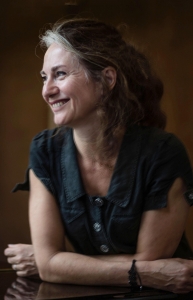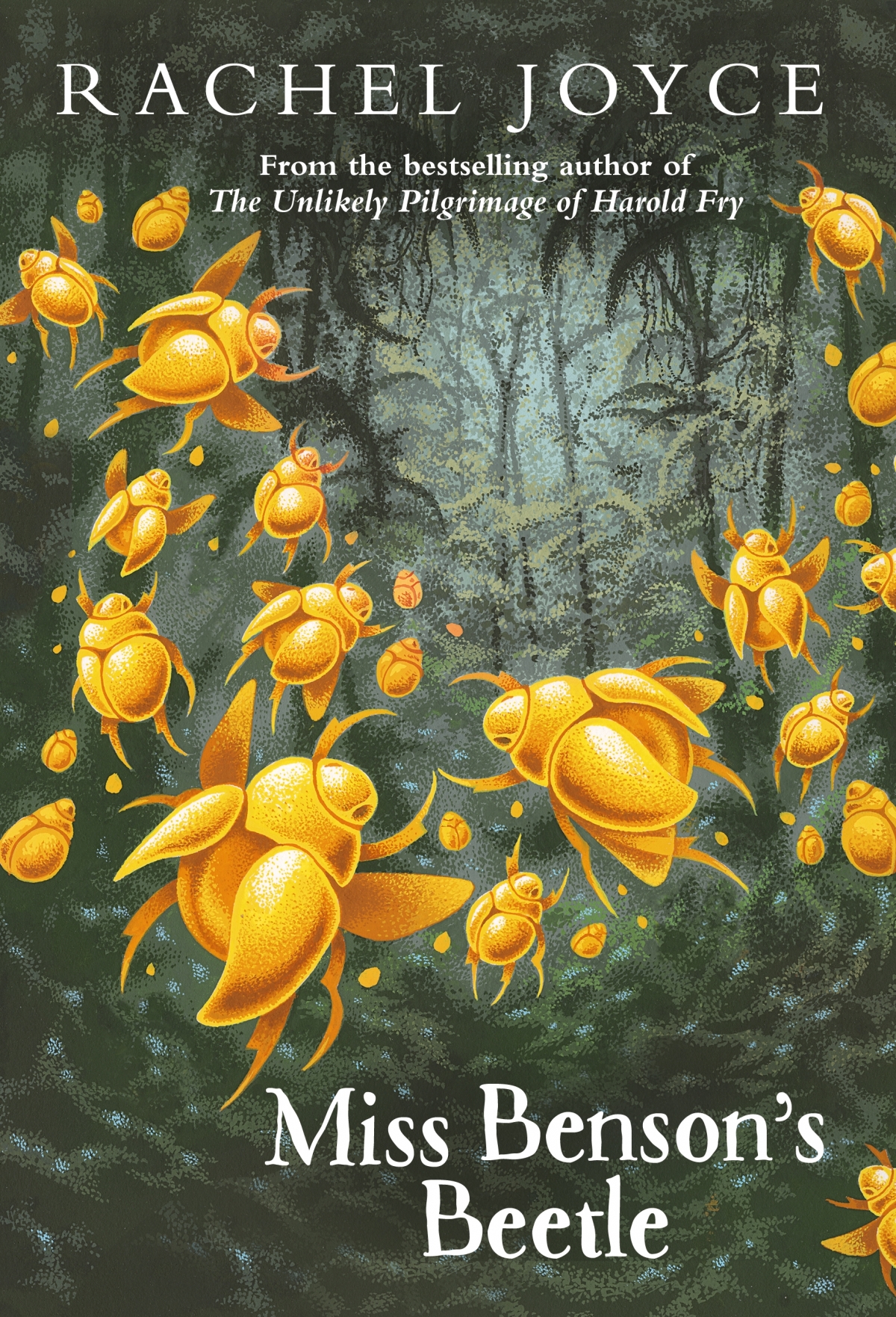
Rachel Joyce is the author of the Sunday Times and international bestsellers The Unlikely Pilgrimage of Harold Fry, The Love Song of Miss Queenie Hennessy, and Perfect. The Unlikely Pilgrimage of Harold Fry was short-listed for the Commonwealth Book Prize and long-listed for the Man Booker Prize and has been translated into thirty-six languages. Joyce was awarded the Specsavers National Book Awards New Writer of the Year in 2012. She is also the author of the digital short story A Faraway Smell of Lemon and is the award-winning writer of more than thirty original afternoon plays and classic adaptations for BBC Radio 4. Rachel Joyce lives with her family in Gloucestershire.
If you haven’t read Rachel Joyce before, her latest book, Miss Benson’s Beetle, will bowl you over. If you are familiar with her work, rest assured that you will not be disappointed. We asked her some questions about a beetle – well, a whole lot of questions about a beetle, actually!
Penguin Random House (PRH): Why a beetle?! (I suddenly realised last week that it could have been a plant or ten million other animals, so why a beetle?)
Rachel Joyce (RJ): I chose a tiny golden beetle because I knew nothing about them – which is a healthy place to start a new book – and also because they are so small. You could tread on them if you weren’t looking. You could certainly miss them. (We miss beetles all the time. An entomologist said to me, ‘Butterflies have got it easy.’)
I first thought about the beetle, though, when I heard a talk about cryptozoology. This is essentially the search for animals whose existence has not yet been proved. I was really inspired by that idea. What does it require to find an animal that no one’s found? It must take knowledge, imagination and faith. It must also take endless supplies of courage because a lot of people are going to laugh at you – especially if, like Margery Benson, you’re an introverted woman in 1950 who wears shoes with holes in them, and you’re an amateur collector. No one is going to take her seriously.
PRH: I’d love to know about the golden beetle – does it exist?
RJ: This particular beetle does not as yet exist. But it might. This is the thing I loved about my research. You begin to realise how much exists that we don’t know about; and how much is being lost. But we can’t know what we’ve lost until what we know what we have. (This also struck me as a main theme of the book, in terms of friendship. We see ourselves most truly when we see what we are not.)
My research was extensive. I met several entomologists who explained to me in layman’s terms why beetles are so important – there are more beetles than any other species. I had an inspirational day at the Natural History Museum with a curator who not only talked to me about being a woman on the field, but also showed me ‘back stage’ at the museum. We went through one of those doors that says ‘No entry to the public’ and suddenly we were in a vault of a room with drawer upon drawer of species. She even showed me Darwin’s collection. That was a really special moment.
PRH: Was it the beetle that then led you to New Caledonia? (I've googled and NC is a 'biodiversity hotspot'.)
RJ: Originally I planned to set the book in the UK, but I quickly abandoned that idea. I knew from the start that I was writing an adventure story for women, and it struck me that in order to find the true spirit of these women, and write with their energy, I was going to have to go on an adventure myself: I was going to have to take away all the ‘props’ I have relied on until now. So I chose New Caledonia – which is, as you say, a biodiversity hotspot, and also happens to be an island very few people have written about. I did endless research. I read travel books, studied maps, found letters, witness accounts, old diary and journal entries about the island. I even managed to track down pamphlets issued to American GI’s when they were posted there during the Second World War.
Sometimes as a writer you can get bogged down with research, just as you can get stopped in your tracks by all the things you don’t know. My answer is that you must not be afraid to use your imagination. Take what you do know and make a leap from there.
PRH: How did your two main characters make themselves known to you?
RJ: This may sound odd but I had a feeling for a long time that I was being stalked by two imaginary women. You could say Margery Benson and her assistant Enid Pretty are parts of me – the introvert and the extrovert. You could say that they were voices somewhere in the unconscious. Or you could say I had a really good idea for a story. I don’t mind. Early on in my writing, I found a photograph of two women - May Morris, the artist and social activist, and her gardener and companion Mary Lobb. I loved this photo. It’s the way they stand together that moves me – Mary in her breeches and tie and jacket, standing squarely in front of the camera, and beaming right at us, while May stares a little off to the side. It’s as though being together allows them to be the individuals they truly are, and this struck me as a very beautiful truth about my friendships with other women. There was something about the energy of Margery and Enid that was like a spur to me as a writer. It made me bold.
PRH: The book really spoke to me at a deeper level, especially during lockdown and the time of reflection that it prompted in many of us.
RJ: It’s strange because lockdown has been a time of reflection for many of us, and a time of stillness, and also a time of extreme anxiety about the future. It has been like living in a paradox; everything is okay, and yet everything is most certainly not. Maybe a story about an adventure, about the wonder of the world, and also the dynamic energy of two women who don’t initially seem to get along very well – maybe all those things make it a very good escape. It kind of answers something inside us – a longing for connection - but also takes us somewhere we can’t go.
PRH: Were there things you were keen to explore during the book, or did it evolve as you wrote it?
RJ: I wanted to look at vocation – what that means as a woman, and how hard it is, but also important, to stay true to it. I wanted to write about motherhood too. Margery longs to find a beetle. Enid longs to be a mother. But most of all, I wanted to celebrate women. That creative energy we have.
PRH: I got the sense of travelling with the women as they went on their adventure. Did the travel and the geography of the book present any challenges / opportunities for research?
RJ: This was almost a lockdown book in its conception – not that I knew the word then – in that I wrote it without going anywhere, except to the hut where I write. (Which is in a field, just a few strides away from our house.) I knew very early on that I wouldn’t be able to go to New Caledonia, but also that if I really researched, I didn’t need to. The challenges were to my imagination, and they were useful to me in understanding the challenges that Margery and Enid undergo. I longed to see New Caledonia, though, and I feel that comes out in the writing.
PRH: I loved the fact that this is a tale about women getting stuck into a great adventure. At times it reminded me of Cheryl Strayed and her boots! What was your inspiration for this?
RJ: I wanted to put women at the centre of a book. In fact, when I thought about it, I didn’t know why I hadn’t done that before. I wanted to write about friendship between women but I felt I would find out more about them if I put them in extreme conditions. So this is when I decided to write an adventure story for women.
I read all the classic male adventure stories, the boys’ own stories, and I watched a lot of films with men basically at the centre, and then I asked myself: How can I use this for women? And it seemed to me that the adventure story is always a quest, and that in order to succeed your heroines must overcome one difficulty after another, each growing in size, until they have acquired the skills they need to find the thing they are looking for. But the biggest obstacles, of course, are the emotional ones inside Margery. The things that set her off on the journey in the first place. We look outside ourselves for the answers, but they are often inside us.
Having said all this, there is a male figure in the book, and he shadows the women like a piece of darkness. He was never supposed to be in the book. He was just supposed to turn up in one small chapter, and then disappear. But he simply wouldn’t leave me alone. I think he couldn’t believe this wasn’t a book about him! So in the end, I used that. Mundic is a broken figure, a man who has been traumatised by war, and now – unlike Margery and Enid – incapable of empathy or change, or indeed love.
PRH: Can I tell you again how much I loved this book? It was so good to read something that wasn't motivated by romantic stuff. That was a true adventure story for women. That had female friendship at its heart.
RJ: As my children grow older, it’s the women in my life that I am turning to. I feel I can cross boundaries with women that I can’t with men. A friend of mine said recently ‘I am proud to be part of this sisterhood’ and I knew what she meant.
_______________________________________________________________________________________________








